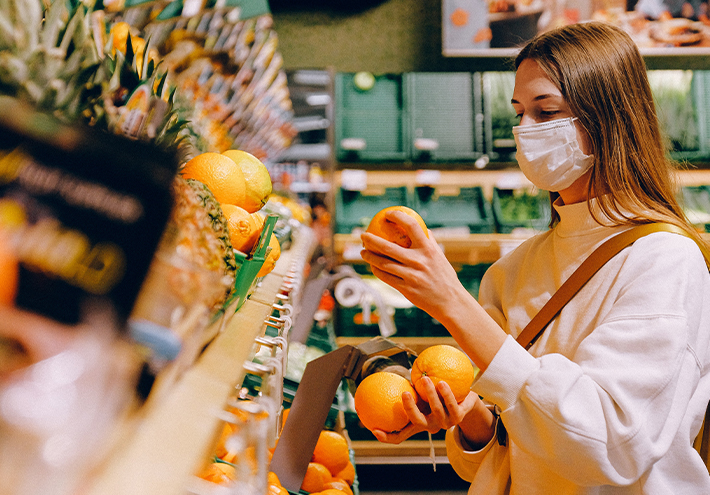MUDr. Alexandra Frolkovičová, nutritional expert
The arrival of coronavirus in Slovakia took away not only our hopes for the economy, but also our personal plans. It impoverished our social life and brought us a hitherto unknown fear. In the end, we were lucky and thanks to draconian measures, the first wave seems to be successfully behind us. It would be naïve to assume that we have got rid of the coronavirus. It is certain that we haven’t, the only question left is how we will live with it. Months of our life together have shown that a good immune system and healthy weight are essential in managing a coronavirus infection. For the second wave, we now have time to prepare and do a lot to focus on these goals. In addition to getting enough sleep or regular exercise, a healthy diet can definitely help us in a fundamental way.
How often to eat
Complications of obesity, such as high blood pressure and diabetes, have been shown to increase the risk of severe coronavirus infection, which is a strong reason for goal number 1: normalizing our weight. For this purpose, we can choose an “intermittent starvation” regimen, where we eat our three main meals, e.g. within an 8-hour interval or try 1-2 days a week completely without dinner (“let’s go”).
Those who do not need to lose weight can spread their three meals into a 10-hour interval. Eating between meals is not necessary and if you do it, it should be seen as an opportunity to increase your intake of fruit and vegetables. We should be hungry at least once a day so there are hunger contractions and proper bowel cleansing. This will help us better prepare our immune system for combat. Good intestinal microflora fundamentally improves our defences against infections.
What foods to focus on to support immunity
Fibre and its specialist: beta-glucan Fibre is known to have myriad beneficial effects, from offering significant help with weight reduction, through cancer prevention, cholesterol control, to immune support. Beta-glucan supports the immune response against pathogens (and therefore viruses). Eating porridge in the morning gives us as much as 1-2 grams of beta-glucan, which is disproportionately higher than that provided by conventional nutritional supplements. Porridge with flaxseed, nuts and fruit is therefore our tip no. 1 to support immunity.
The right amount of protein, especially plant-based proteins
It is known that a lack of essential amino acids, the basic building blocks of proteins, can negatively affect our immunity. In modern life, however, we rather suffer from the consequences of excessive protein intake, especially proteins of animal origin. This is not conducive to our defences. Immunity is supported by a reduction in the intake of animal proteins (you do not have to eat meat every day) and high-quality plant-based proteins, which will supply us with the whole spectrum of essential amino acids (although each plant source has more of some amino acids and less of others). This group includes legumes, seeds and nuts, whole grain cereals (yes, they are not just a source of carbohydrates). A particularly complex source of essential amino acids is soya, with an emphasis on quality soya: tofu produced in a natural and traditional way. In addition, it has an infinite number of quick and easy culinary uses. In addition, soy is rich in arginine, an amino acid with a known immunostimulatory effect. Meat and tofu are often compared as sources of protein. Both sources are rich in protein, but meat also contains unwanted fats and various other harmful substances. Eating it regularly increases the risk to patients who are in the risk group in terms of the adverse development of coronavirus infection (obese patients with high blood pressure, diabetes or higher cholesterol levels). On the contrary, tofu is a safe source of protein, does not contribute to weight gain, does not increase cholesterol levels or blood pressure (quite the opposite) and it also has a good shelf life of about 4-6 weeks. Also, foodborne infection is much more likely when consuming animal sources than plant ones.
Known immuno-pair: zinc and selenium
Zinc deficiency can adversely affect both cellular and antibody immunity. Older people with zinc deficiency are e.g. more prone to pneumonia. In clinical studies, it has been confirmed that the normalization of zinc levels occurred about two weeks after substitution, with a subsequent decrease in markers of inflammation and oxidative stress. In addition to meat (which we should limit), zinc is abundantly present in whole grain forms of cereals, nuts and seeds. Zinc intake can also be supplemented in the form of nutritional supplements. The preventive daily dose is 15-20 mg, at a time of the viral infection the dose can be doubled for several days and even tripled for the first three days in a healthy person. It is easier with selenium; the daily dose is simply provided by three brazil nuts.
Vitamins A, C and E have not lost their importance
Beta-carotene is an excellent precursor of the mucosal vitamin A. The advantage of it is that you cannot overdose on it and therefore the daily consumption of carrots is important in supporting our defences – that’s our nutritional tip no. 2. Vitamin E supports both cellular and antibody immunity and it is ideally consumed with omega-3 fatty acids. In this combination, it is found in nature in nuts and seeds. This is one of the reasons why it is recommended to eat a handful of nuts and seeds a day – our tip no. 3. Vitamin C is abundant particularly in fruits and vegetables (e.g. peppers, citrus fruits, strawberries, kiwis, etc.). Today, increased intake in the form of megadoses in tablets or in the form of infusion therapy is being discussed. Authors do not agree on the correct recommended dose in the form of a nutritional supplement, but it is certain that a dose higher than 2 g is not recommended for adults (in the form of nutritional supplements, tablets). Regardless of the debate over the right dose of vitamin C, it must always be emphasized that intake in the form of natural sources is extremely important.
The more colourful, the more effective
Every colour in plant-based food provides a different kind of health protection not only through vitamins and minerals, but especially through its unique phytochemicals. Therefore, when choosing fruits and vegetables, it is advisable to consume different colours during the day. Purple vegetables are a rich source of anthocyanins, red contains lycopene, orange carotenoids, green folic acid or indole-carbinol and white contains sulfides with anti-cancer activity. And these are just individual examples of phytochemicals, of which there are thousands in plants. These important components of plant food, with their antioxidant effect, each intervene at a different level and thereby provide a variety of immune support, protection against cancer, cardiovascular disease or diabetes. Our tip no. 4 – consume at least half a kilo of fruits and vegetables a day and take care to have a variety of colours. Every day, have at least half a cup of small berries and some type of Brassica (the cabbage family, which includes broccoli, cauliflower, rocket and radish in addition to cabbage), we consider these species to be the most important.
The daily colour scheme can be as follows:
Breakfast: porridge with cinnamon, flaxseed, almonds, grated apple, banana, blueberries, flavoured with lemon juice and honey
Lunch: grated tofu on a leek with turmeric, natural rice, mixed salad with green leaves
(Snack: carrot salad with lemon)
Dinner: salmon with garlic, stewed broccoli, tomato salad with onion
The lungs love quality fats
Low fat diets have long gone out of fashion, it’s much more important to choose the right sources of fats. Omega-3 fatty acids are still the leaders, and they are known for their anti-inflammatory effect. In addition to fish, omega-3 fatty acids are found mainly in seeds (flax, chia and hemp), which can provide a daily dose in two tablespoons. Intake of monounsaturated fatty acids, which are found in olive oil, is also important. Therefore, in the kitchen it is advisable to prefer olive oil to sunflower oil, because sunflower oil is rich in omega-6 fatty acids, which have a pro-inflammatory effect (they promote inflammation).
You need to be ready for viruses
The use of the anti-inflammatory and antiviral effects of spices and herbs also has an important place in the prevention and supportive treatment of infections of various kinds. Now is the right time for the daily use of Indian spices (ginger, turmeric, cinnamon, cardamom, cumin, etc.), which we can add to any hot meal. Herbs (parsley, basil, oregano, dill, marjoram, etc.) can be used mainly dried or frozen.
Vitamin D is not just for bones
Vitamin D is very important, even though in our conditions there is little chance that we will get a sufficient dose only from our diet. Even many people who spend the recommended half hour in the sun every day often have low levels of vitamin D in their blood. This vitamin plays an important role in our defences and having enough of it in the body is one of the most important prerequisites for how to manage a viral infection well. An appropriate amount of vitamin D in the form of a nutritional supplement should be derived from the current level of vitamin D in the blood, however do not exceed a daily dose of about 2000 IU, which might not be enough in the case of a more significant deficiency. In that case higher daily doses may also be considered, but rarely higher than 4000-5000 IU, with 10,000 IU considered to be the upper limit of safe daily intake (such high doses should definitely only be used on the advice of a doctor).
Fluids also help
Sufficient hydration is the alpha and omega for coughs and fevers, when we often do not want to eat at all. Alcohol and sweetened drinks are not allowed, fruit juices should also be limited due to their high sugar content. However, immunity can be supported by small amounts (50 – 100 ml) of 100% juice from small berries (sea buckthorn, blueberries, chokeberry, blackcurrant, blackberry, etc.). Out of the different kinds of tea, ginger tea is particularly suitable, which can be supplemented with various other spices, e.g. cloves, cinnamon, cardamom, etc., herbal and green teas, minerals containing calcium and magnesium.
How valuable, healthy food should look
A very simple example of healthy food is the increasingly modern “Macro bowls” or “Buddha bowls”, which means a bowl with a special composition. The basis is a whole grain cereal in combination with several types of cooked and raw vegetables, herbs and a small amount of a protein source (fish, legumes, tofu, tempeh, cheese, lean meat). The food is tasty with added olive oil and lemon, or a special dip. This composition is especially suitable for breakfast and lunch, if you need to reduce weight, then simply leave out the cereal in the evening. This type of food is not only tasty, but contains most of the important nutrients that we mentioned in this article. Its preparation is simple, fast and there is an infinite range of possibilities.
Topical fact at the end:
At the Basel Faculty of Pharmacy in Switzerland, they recently had a great idea: they used computer analysis to select, from a database of almost 700 million substances, those that are able to block a key enzyme of the coronavirus (so the virus is unable to reproduce). One of them is of natural origin. It aroused great enthusiasm when the information appeared in the media that this substance (taxifolin), which is in the flavonoids group, is found, among other things, in wine and chocolate. However, it is too early to draw any conclusions about the therapeutic effect of taxifolin, although we will not be mistaken if we consume more healthy foods containing it, with two reservations. By no means does this mean drinking wine every day, because the safe daily dose of alcohol is zero. The disadvantages of regular alcohol intake would very likely outweigh the expected benefits of taxifolin intake. And as for chocolate: only dark chocolate with a high percentage of cocoa is healthy and not the cheaper types of milk chocolate which are often used. The safest for everyone is to drink green tea daily, have a piece of dark chocolate and enjoy a good source of flavonoids such as small berries, grapes, apples or onions.






